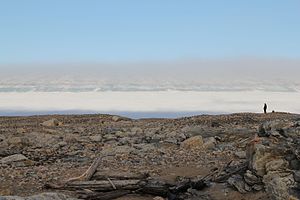Kvitøya
| Kvitøya | ||
|---|---|---|
| Ice-free area Andréeneset in the west, with a view of the glaciated dome | ||
| Waters | Arctic Ocean | |
| Archipelago | Spitsbergen | |
| Geographical location | 80 ° 10 ′ N , 32 ° 25 ′ E | |
|
|
||
| length | 42 km | |
| width | 22.5 km | |
| surface | 682 km² | |
| Highest elevation | 410 m | |
| Residents | uninhabited | |
Kvitøya (German: "White Island") is an island of about Norway belonging Svalbard Archipelago (norw Svalbard.) In the Barents Sea east of the island northeast country . It is the easternmost island of Svalbard and therefore the easternmost part of Norway. Victoria Island , which belongs to the Russian archipelago of Franz-Joseph-Land, is only 62 kilometers to the east . Kvitøya has an area of 682 km² and is uninhabited.
climate
As on the entire Svalbard Archipelago, the climate is high arctic due to the high geographical latitude. While the West Spitsbergen Current (the last northern branch of the warm Gulf Stream ) on the west coast of Svalbard still brings relatively high temperatures and a lot of precipitation for arctic conditions, the cold East Spitsbergen Current Kvitøya with its cold water and ice masses has a firm grip on the climate. Even in summer, the islands cannot always be reached due to the ice conditions.
geology
The east side of the island consists largely of the hard rock gabbro . The western Andréeneset consists of a colorful mixture of reddish migmatite and dark gneiss , with many dike rocks . It probably dates from the Mesoproterozoic , so it's over a billion years old.
landscape
Kvitøya is almost completely covered by the 675 km² large ice cap Kvitøyjøkulen . Officially there are only three ice-free places. The largest of these is Andréeneset in the west with five square kilometers of rocky-gravelly flat land. The others are Hornodden and Kræmerpynten to the east. Kræmerpynten , the more northerly of the named headlands on the east coast, is also Norway's easternmost landmass.
Flora and fauna
For the most part, Kvitøya is a hostile ice desert. The vegetation on the few ice-free areas consists mainly of moss and lichens . There are arctic tern colonies on the island , and polar bears also stay there from time to time.
history
There are legends about a mysterious "Giles Land" or "Gillis Land", first sighted in 1707 by the Dutchman Cornelius Giles . Giles-Land appeared on various maps in all sizes, shapes and positions for many decades and was not entered for the first time until the late 19th century. This Giles-Land (or Kvitøya, as it is called today) became famous through the discovery of the expedition of Salomon August Andrée , which finally failed there , who drove north from Virgohamna on Danskøya with two companions in the hydrogen balloon Örnen in 1897 . The three involuntarily landed on the ice about 300 km north of Andréeneset, then turned south on foot and came to Kvitøya on October 5, 1897, where they died after a few days or weeks. The camp was only discovered in 1930 by the Norwegian Bratvaag expedition led by Gunnar Horn (1894–1946). Today there is a memorial to Salomon August Andrée, Knut Frænkel and Nils Strindberg on Andréeneset .
On May 25, 1928, the airship Italia of the North Pole expedition Umberto Nobiles crashed at Foynøya . It lost so much height that the driver's gondola hit the pack ice and tore off. Six crew members floated away in the keel frame and the motor gondolas with the steeringless airship hull. No trace of them was ever found. The Czech expedition member František Běhounek describes in his book The Stranded People of the Polar Sea ( Trosečníci polárního moře ) that almost half an hour later a rising column of smoke was observed on the horizon from the site of the accident near Kvitøya. Since this corresponded to the wind direction, it should have marked the final crash of the Italia near Kvitøya.
The Northeast Svalbard Nature Reserve
Kvitøya is entirely located in the Northeast Svalbard Nature Reserve . Any technical intervention (construction of buildings, operation of mines, etc.), any leaving of rubbish and any disturbance or introduction of animals and plants is prohibited there. In addition, motorized vehicles are not allowed to enter the country. The Sysselmann can also completely block areas for visitors.
Individual evidence
- ↑ Kvitøya on the website www.spitzbergen.de , accessed on March 14, 2018.
- ^ Johann Jacob Egli: Nomina Geographica: Language and factual explanation of 42,000 geographical names of all regions of the earth . Georg Olms Verlag, 1973 ( Nomina Geographica in the Google book search).
- ^ Title of the 1955 edition of his book Trosečníci na kře ledové , published in 1928

